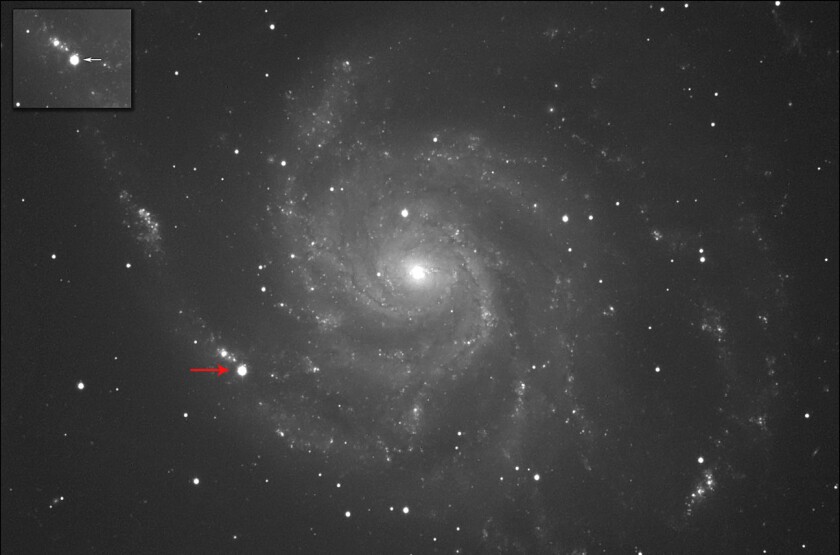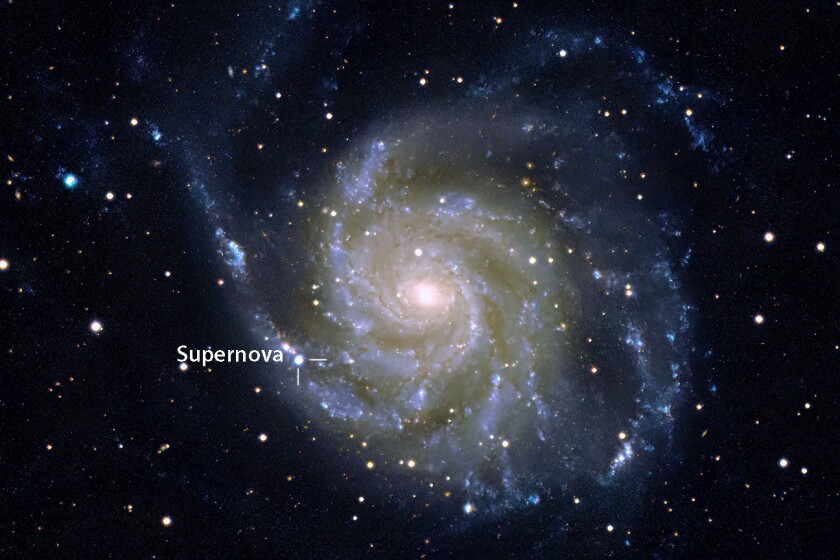One day the familiar star Betelgeuse in Orion will explode as a supernova. When it does astronomers predict it will shine as bright as the full moon. To our eyes the supergiant star will look even brighter because all that light will be scrunched into a pinpoint. You'll be able to find your way at night by its light, and see your shadow, too.

But why wait and hope for a single star to explode when supernovae are erupting everywhere all the time? In 2021 alone more than 2,200 were discovered and named. Not a single one hailed from our galaxy the Milky Way. The last "local" blast visible with the naked eye occurred around the year 1680 in Cassiopeia.
Good news. There are an estimated two trillion other galaxies out there. Both amateur and professional astronomers routinely monitor a host of them and turn up plenty of supernovae, all of which require a telescope to see except in rare cases. Most are really, really faint and look like tiny points of light embedded in the galaxy's disk or close by. They're all too far away to distinguish details of the actual explosion, but that doesn't diminish the wonder of knowing you're witnessing the sudden, catastrophic destruction of a star. Supernovae can shine with the light of 10 billion suns!
Yeah, they're a big deal. Especially so when a supernova appears in a nearby galaxy like M101, known as the Pinwheel for its whorl of spiral arms. When one erupts relatively close by there's a good chance it will become bright enough to spot in a modest telescope. I'm delighted to report that's exactly what's happening right now.

Japanese amateur astronomer Koichi Itagaki discovered the object on May 19 at magnitude 14.9, which is near the limit of a 12-inch telescope. But it quickly grew brighter. Only 12 hours later I spotted it at 13.5 in my scope. As of Wednesday, May 24, it had climbed to magnitude 11, likely as bright as it will get. While not visible with the naked eye or binoculars a 6-inch telescope will show the cataclysm without difficulty when the moon doesn't interfere.
ADVERTISEMENT

M101 is an 8th magnitude galaxy located just off the handle of the Big Dipper which stands nearly overhead at nightfall in late May. Seen from a dark sky with minimal city glow the galaxy looks like a faint, fuzzy spot in standard 50mm binoculars.
To find it in your telescope, use a low power eyepiece (around 50x.) Locate Mizar in the bend of the handle and follow the "breadcrumb trail" of stars I've marked to the galaxy. Through the scope you should see a soft-glowing haze of light with a slightly brighter center. The supernova lies a short distance to the southeast of the center. Fortunately, there are no other obvious stars in the galaxy's disk to confuse it with.

The detailed chart below will not only help you pinpoint the supernova but you can use the numbered stars to monitor its changing brightness. The numbers are magnitudes with their decimal points omitted. For example, 91 means a star of magnitude 9.1. The greater the number the fainter the star. Right now 2023ixf is close to peak brightness, but it will gradually fade. Unlike typical explosions that are over in a flash supernovae blasts linger for weeks and months.

The timing of the eruption couldn't have been better. M101 is high in the sky in May and June and so far north it never sets for observers at mid-northern latitudes. That means lots of time to follow the star's final act.
There are several varieties of supernovae, but astronomers have identified 2023ixf as the remains of a supergiant star like Betelgeuse. Gravity, single-minded as ever, wants to crush the star into a tiny ball. The only thing preventing that from happening is the heat and outward pressure pushing back from the core.

Nuclear fusion in the core squeezes atoms of hydrogen together to create energy and a new element, helium. Every second the sun fuses about 600 tons of hydrogen to yield 596 tons of helium, with 4 tons converted into pure energy. Einstein was the first to point out that matter is really little more than a very concentrated form of energy.
Fusion keeps our favorite star in equilibrium with gravity and provides the abundant heat and sunshine that make Earth supremely habitable. Eventually the sun will run out of hydrogen in its core and instead fuse helium into carbon and oxygen to keep the lights on. But that's as far as it can go.
More massive stars have hotter cores able to fuse elements beyond helium to make neon, silicon and iron. But there's a problem. Once iron is made, fusion quickly comes to a halt. Iron is super stable and resists being fused into something else. With no push-back against gravity, the supergiant suddenly collapses.
ADVERTISEMENT
When all that material hits the core it creates shock waves that reverberate through the star and rip it to bits. Although we see little more than a point of light (because of the supernova's great distance), up close the catastrophic explosion must be utterly frightening, literally hell-fire unleashed. I try to remind myself of the tumult each time I return to the supernova, even as frogs sing from nearby ponds and peace settles over the dark land.
To keep tabs on 2023ixf and see recent photos go to David Bishop's Latest Supernovae site at rochesterastronomy.org, and click on the 2023ixf link in the upper left corner of the page.











